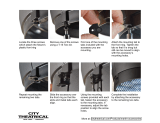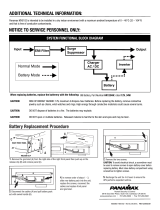
vii
Table of Contents
SAFETY INFORMATION .......................................................................................iii
Chapter 1 INSTALLATION
1.0 Introduction..........................................................................................................1-1
1.1 General Information .......................................................................................1-1
1.2 Plan the Installation........................................................................................1-1
2.0 DC Power Cable Installation................................................................................1-1
2.1 Planning the Power Cable Installation ...........................................................1-1
2.2 Power Cable Installation Procedure...............................................................1-2
3.0 Trunnion Installation ............................................................................................1-4
3.1 Planning the Mounting Trunnion Installation..................................................1-4
3.2 Trunnion Installation Procedure.....................................................................1-4
3.3 Control Head Mounting Position ....................................................................1-5
4.0 Antenna Installation.............................................................................................1-5
4.1 Mobile Radio Operation and EME Exposure .................................................1-5
4.2 Selecting an Antenna Site..............................................................................1-6
4.3 Antenna Installation Procedure......................................................................1-6
4.4 Completing the Installation.............................................................................1-7
5.0 Installation Options..............................................................................................1-9
5.1 Radio Mounting in Dashboard........................................................................1-9
5.2 External Speaker Installation .......................................................................1-10
5.3 Remote Control Head Installation................................................................1-11
6.0 Accessory Connections.....................................................................................1-13
6.1 Accessory Connector Pin Functions............................................................1-13
Chapter 2 REDUCING NOISE INTERFERENCE
1.0 Introduction..........................................................................................................2-1
1.1 Noise Sources................................................................................................2-1
1.2 Radiated Noise...............................................................................................2-1
1.3 Conducted Noise............................................................................................2-2
1.4 Induced Noise ................................................................................................2-3
2.0 Operation of a Conventional Ignition System ......................................................2-3
2.1 Introduction ....................................................................................................2-3
2.2 Sources of Ignition Interference .....................................................................2-3
3.0 Detection of Noise Sources.................................................................................2-5
3.1 Noise Detection Procedure............................................................................2-5
3.2 Sources of Noise............................................................................................2-7
4.0 Noise Reduction Techniques...............................................................................2-7
4.1 General ..........................................................................................................2-7
4.2 Ignition System Interference ..........................................................................2-8
4.3 Alternator/Generator Whine...........................................................................2-9





















